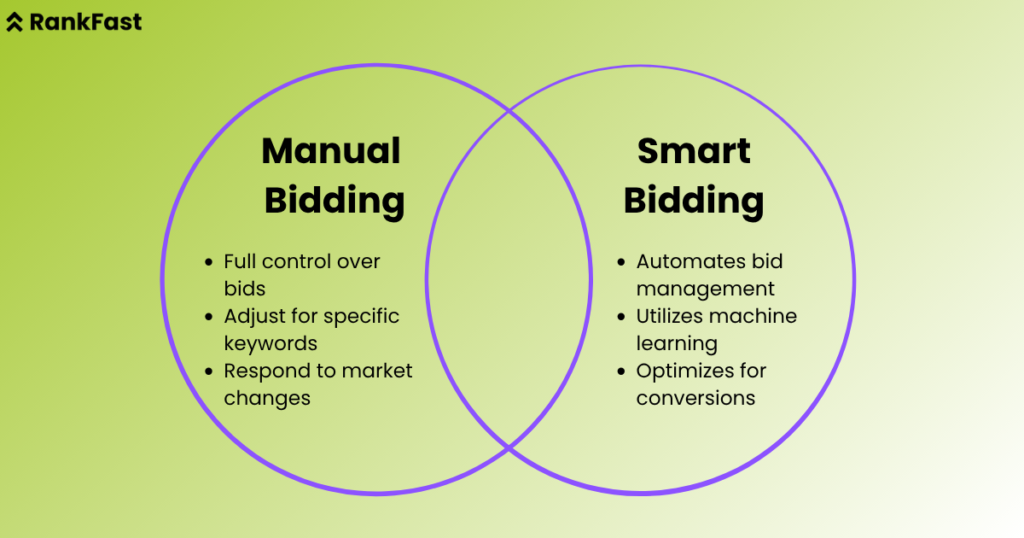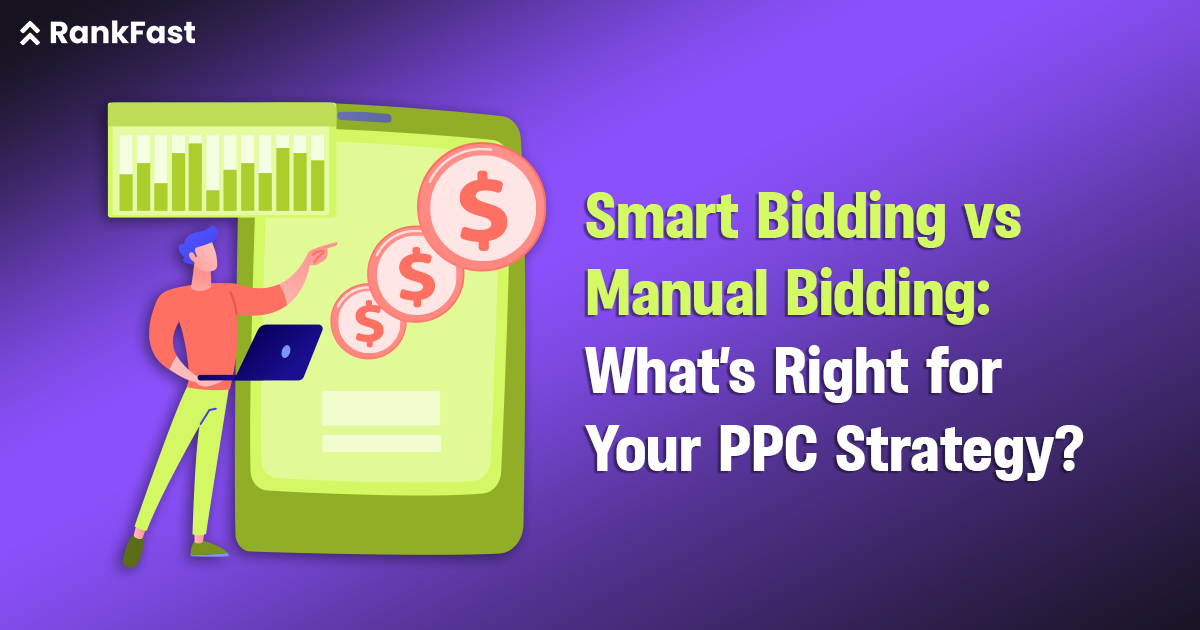Spending more on ads but getting fewer conversions? Many marketers overlook one crucial aspect: bidding strategy significantly impacts campaign results. Choosing the wrong one means wasted money. Some pick Smart Bidding without testing. Others hold on to Manual Bidding too long. In this blog, we explain when to use Smart Bidding vs Manual Bidding and how to choose what suits your PPC strategy.
What Is Smart Bidding?
Smart Bidding is a machine-learning bidding method inside Google Ads. It uses your conversion data, user signals, device, time, browser, and location to set bids automatically. You don’t control each bid. Google does.
There are four main types of Smart Bidding:
- Target CPA (Cost per Acquisition): Google sets bids to get conversions at a set average cost.
- Target ROAS (Return on Ad Spend): Focuses on getting a specific revenue from each rupee spent.
But here’s a fact: To use Target ROAS, Google requires at least 15 conversions in the last 30 days.
- Maximize Conversions: Utilize your full daily budget to achieve the highest number of conversions.
- Maximize Conversion Value: Allocate your budget to achieve the maximum total revenue, not just conversions.
Smart Bidding is one of the advanced PPC bidding strategies that adjusts bids in real-time. It learns from your past data and then predicts which clicks are likely to convert.
It removes manual work. It suits advertisers who have enough data, want speed, and need automation.
But it does not work like magic. It needs clean, stable data. If your account is new or you have fewer than 30 conversions in 30 days, it may not learn properly.
What Is Manual Bidding?
Manual Bidding means you set the cost per click (CPC) for each keyword or ad group. You decide how much to bid and where to show. It gives full control over spending.
You can:
- Raise bids for keywords with high ROI
- Lower bids for poor-performing areas
- Set device-level or location-level adjustments
Manual Bidding works best for campaigns where:
- You know which keywords convert
- Your budget is tight
- You want to test slowly
This method is helpful in testing new markets, controlling ad spend, and maintaining clean PPC accounts.
It suits businesses that don’t trust automation or want to handle bidding decisions manually.
Manual Bidding also requires you to examine campaign data more closely, including CPC, CTR, Quality Score, and conversion rate, before making decisions.
But it takes time. Mistakes can be expensive if not closely monitored.
Smart Bidding vs Manual Bidding: Benefits

Smart Bidding performs better after account maturity, rather than during the testing phase. Manual Bidding gives full control. That suits small teams, startups, and budget-focused accounts.
Smart Bidding: Benefits
- Saves Time
You don’t need to adjust bids daily. Google does it using machine learning. - Real-Time Adjustments
Google adjusts bids based on factors such as time, device, audience, and more. - Works at Scale
Best for big accounts with hundreds of keywords. You set the goal; Google handles the rest. - Supports Broad Match Keywords
Smart Bidding works well with broad match when combined with proper conversion tracking. - Adapts to Trends
It sees patterns faster than humans. If weekends result in more sales, the adjustment is made automatically.
Manual Bidding: Benefits
- Full Control
You set the bid. You decide how much to pay for each click. - Clear Testing
Ideal for A/B tests, new keywords, new locations, and new audiences. - No Learning Period
Unlike Smart Bidding, Manual Bidding starts working from day one. - Better for Low Volume
When data is low, you can still run stable campaigns. - Quick Response
If the cost per conversion increases, you can take action immediately.
Smart Bidding vs Manual Bidding: Limitations
Smart Bidding and Manual Bidding have their strong points but also have their limitations. Knowing both helps plan better.
Smart Bidding: Limitations
- Needs Data
Without past conversions, it can’t learn. For example, Target ROAS needs at least 15 conversions in 30 days. - Slower Testing
Hard to test new keywords or ad copy. Smart Bidding often takes 7–14 days to learn. - Lack of Transparency
You can’t see how bids are calculated. That’s risky when the budget is tight. - Not Always Profitable
Sometimes, it chases volume rather than profit. Especially in Maximise Conversions mode.
Manual Bidding: Limitations
- Time-Consuming
Needs regular monitoring. Daily bid adjustments can consume a significant amount of time. - Hard to Scale
Managing thousands of keywords manually is not realistic. - Less Use of Signals
Manual Bidding doesn’t use signals like time, device, or user behaviour the way Smart Bidding does. - Mistakes Cost Money
One wrong bid can exhaust your budget or miss good traffic.
Performance Comparison: Smart Bidding vs Manual Bidding
| Feature | Smart Bidding | Manual Bidding |
| Setup Time | Quick, once the data is ready | Longer, it needs constant attention |
| Learning Curve | Needs past data to work | Works instantly with no data |
| Bid Control | Low | Full |
| Transparency | Low | High |
| Scale Handling | Very High | Poor at a large scale |
| Best Use Case | Mature accounts, lots of data | Small budgets, early testing phase |
| Ad Platform Signals Use | Full use (device, time, browser) | Limited to manual adjustments |
| Maintenance Effort | Low | High |
Smart Bidding vs Manual Bidding: Both bidding types perform well when used in the right stage of the funnel.
When to Use Smart Bidding
Smart Bidding works best when:
- You have enough conversions
- You trust automation
- You need to scale quickly
- You run Shopping, Display, or Video campaigns
Use it when your campaign has:
- Stable conversion tracking
- Clean historical data
- Defined ROI targets
Example:
An e-commerce store with ₹2L monthly ad spend should try Target ROAS to balance volume and margin.
Smart Bidding is a great choice among Google Ads bidding options when you’re managing multiple products and prioritizing ROAS over CPC.
Remember to:
- Set clear goals
- Avoid frequent changes
- Let it complete the learning phase (minimum 7 days)
When to Use Manual Bidding
Manual Bidding is better when:
- Your budget is small
- You are testing keywords
- You want full bid control
- Your account has no past data
Use it if:
- You run niche campaigns with low search volume
- You want to build the campaign structure from scratch
- You need quick experiments without waiting
Example:
A coaching center in Pune testing new keyword sets, such as “GRE classes in Baner,” should begin with Manual Bidding.
Also, use it when you face high CPCs and want to pull back.
Manual Bidding also suits remarketing campaigns where you control bids tightly based on the audience list.
Hybrid Approaches and Testing Strategies
In many cases, a hybrid PPC bidding strategy brings the best outcome. You mix Smart and Manual Bidding for different campaign goals.
Common Hybrid Techniques:
- Start Manual → Move to Smart
Test new campaigns manually. Once you get stable conversions, shift to Target CPA. - Use Manual for High-Risk Campaigns
For expensive keywords, keep control with Manual. For broader campaigns, use Smart Bidding. - Segment by Campaign Type
Use Smart Bidding for Shopping or Display. Use the Manual for Search with high intent. - Test by Device
Split campaigns by mobile/desktop. Apply different bidding strategies for each. - Smart with Rules
Even within Smart Bidding, use custom rules for budget control and bid limits.
Always run A/B tests. Use Google Ads Experiments. Compare CPA, CTR, and ROAS across both methods.
Don’t switch too often. Let each bidding model run for at least 14 days before making a judgment.
Track:
- Search term quality
- Conversion lag
- Audience response
Utilize tools such as Google Analytics, Search Console, and Offline Conversion Import to track in-depth funnel results.
Final Thoughts
Choosing Smart Bidding vs Manual Bidding depends on your budget, data, and campaign stage. Smart saves time and scales well, but only when the data is ready. The manual gives control, but it requires effort and skill. Try both. Test often. Adjust with logic, not guesswork. Start lean, grow smart, scale fast.
At Rankfast, we manage Google Ads bidding strategies for brands seeking improved returns without confusion. Let’s build your PPC engine.
FAQs
1. What’s the best bidding strategy in Google Ads for beginners?
Start with Manual Bidding. It helps control your CPC and test new keywords safely. Later, transition to Smart Bidding once you achieve stable conversions.
2. How long does Smart Bidding take to learn?
Usually 7–14 days. Avoid making changes during this time. Let the algorithm collect enough data to adjust properly.
3. Can I use Smart Bidding with a small budget?
Yes, but only if you have a sufficient number of conversions. For small budgets with no prior history, Manual Bidding is a safer option to start with.
4. Is Smart Bidding always better than Manual?
Not always. Smart Bidding works well with strong data. Manual work is more effective when testing, experimenting, or closely controlling costs.
5. Can I mix Manual and Smart Bidding in one account?
Yes. Many advertisers use Manual for Search and Smart for Display or Shopping. Choose based on campaign goals, not just ease.

Leave a Reply